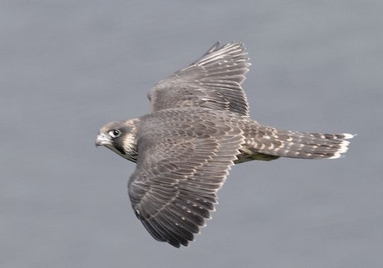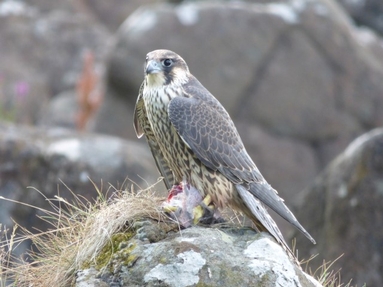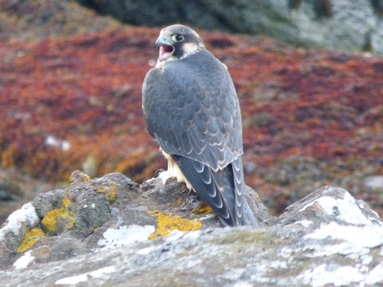Peregrine
This falcon is cosmopolitan, breeding on every continent except Antarctica. In many areas of the world, Peregrine became an endangered species because of the widespread use of certain pesticides, especially DDT. Since the ban on DDT from the early 1970s, populations have recovered, supported by large-scale protection of nesting places. In Scotland Peregrine is a scarce, though widespread, resident breeder and is also a winter visitor from Fennnoscandia. Arran is a nationally important area for this Schedule 1 protected species and here Peregrine breeds on suitable coastal and inland sites. From the recently published Arran Bird Atlas 2007-2012 the species has become more widespread in the last forty years. There are around twelve occupied breeding territories with the number of young fledged each year, varying depending on factors like food availability and weather.



The courtship display can usually be seen in February into March until eggs are laid. The clutch size varies usually from one to four eggs and these are incubated for about thirty days. The small young are particularly vulnerable to adverse weather and are brooded by the female. Young are fledged in about five to six weeks. On Arran, breeding pairs tend to remain in their territory throughout the year.
The male and female have similar markings and plumage. As in many birds of prey the Peregrine displays marked reverse sexual dimorphism. This means that the female is up to 30% larger than the male. The back and the long pointed wings of the adult are usually bluish black to slate grey. The white underparts are barred with thin clean bands of dark brown or black. The tail is relatively short, narrow, and rounded at the end with a black tip and a white band at the very end. The top of the head and a "moustache" along the cheeks are black, contrasting sharply with the pale sides of the neck and white throat. The cere, the fleshy covering at the base of the bill, is yellow, as are the feet, and the beak and claws are black. The upper beak is notched near the tip, an adaptation which enables falcons to kill prey by severing the spinal column at the neck. The immature bird is much browner with streaked, rather than barred, underparts, and has a pale bluish cere. The three photographs are of immature birds.
Peregrines are formidable hunters. They feed almost exclusively on medium sized birds like pigeons, gulls, crows, waders and thrushes. They hunt in the open sky. Circling at height they watch for prey often far below. When they sight their prey, the wings are half closed and the bird goes into a steep, swift dive, called a stoop. Reaching speeds of over 300 kilometres an hour the victims are hit with the talons, caught and dispatched by the beak. Their eyesight is excellent and at these high speeds their nictitating membrane (third eyelid) is used to spread tears, clear debris from their eyes, maintain vision and protect the eye when they impact with prey. To breathe at these high speeds, their nostrils contain a cone shaped structure that causes the air rushing past to spin and to be sucked into the lungs. With these adaptations, when performing the stoop the Peregrine Falcon can reach faster speeds than any other animal on the planet.